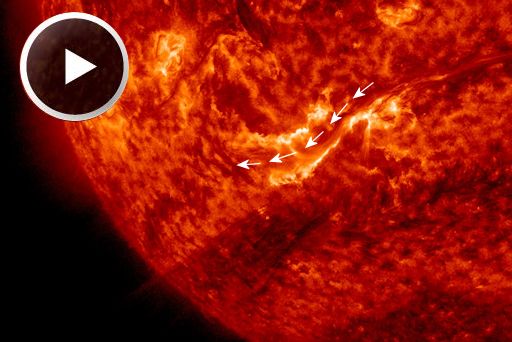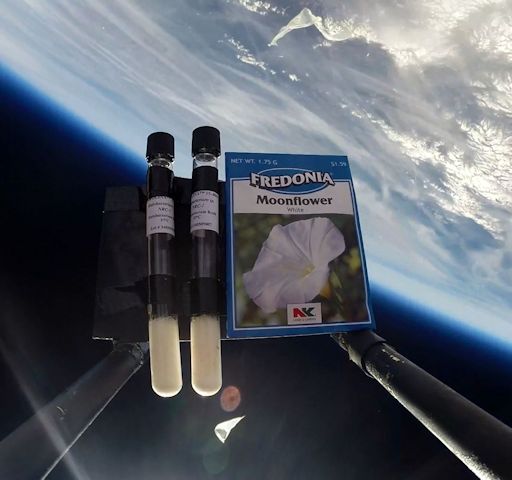Learn to photograph Northern Lights like a pro. Sign up for Peter Rosen's Aurora Photo Courses in Abisko National Park. | | |
CHANCE OF STORMS--REVISED: A CME hurled into space by this weekend's 'canyon of fire' eruption (described below) probably won't hit Earth after all. A new analysis by NOAA forecasters suggests that the cloud will sail south of our planet on April 7-8 and not triger geomagnetic storms when it passes. Aurora alerts: text, voice
THE OZONE FRINGE: Lunar eclipses are supposed to be red. When the Moon slips into the shadow of our planet, the lunar landscape transforms from gray to amber because of sunlight scattered from the top of Earth's atmosphere. Most people who watched last Saturday's eclipse did indeed observe a rosy hue. Yet a few observers noticed something extra--a band of blue:

"A blue band was visible through the eyepiece of my telescope and looked even better in the image," reports Eliot Herman of Tucson, Arizona. "I took this picture just before maximum eclipse using a Questar Q3.5 and a Nikon D810 digital camera."
The blue color is caused by ozone. Atmospheric scientist Richard Keen of the University of Colorado explains: "Most of the light illuminating the Moon passes through the stratosphere, and is reddened by scattering. However, light passing through the upper stratosphere penetrates the ozone layer, which absorbs red light and actually makes the passing light ray bluer." This can be seen using binoculars or a small telescope as a turquoise-blue border around the red.
More examples of the "ozone fringe" may be found in the eclipse gallery. Take a look!
Realtime Eclipse Photo Gallery
'CANYON OF FIRE' OPENS ON THE SUN: A filament of magnetism stretching halfway across the sun erupted during the late hours of April 4th (22:30-23:30 UT). The eruption split the sun's atmosphere, hurling a CME into space and creating a "canyon of fire," shown here in a movie recorded by the Solar Dynamics Observatory:

The glowing walls of the canyon trace the original channel where the filament was suspended by magnetic forces above the sun's surface. From end to end, the structure stretches more than 300,000 km--a real Grand Canyon.
Fragments of the exploding filament formed the core of a CME that raced away from the sun at approximately 900 km/s (2 million mph): image. The cloud is expected to narrowly miss Earth, sailing south of our planet on April 7-8. Solar flare alerts: text, voice
Realtime Space Weather Photo Gallery
MARS MICROBES AND MOON FLOWERS: Astrobiologists have long wondered if halobacteria, a terrestrial extremophile with a special talent for shielding itself from UV radiation, could survive on the planet Mars. To find the answer, the students of Earth to Sky Calculus have been flying halobacteria onboard balloons to the top of Earth's atmosphere. On April 1st, these samples reached an altitude of 110,500 feet:

During the flight, onboard sensors registered temperatures as low as -58 C, air pressures of 1% sea level, and cosmic radiation levels 40 times Earth-normal. Those are conditions akin to the planet Mars. Two and a half hours after they were launched, the bacteria landed near the Eureka Dunes in Death Valley National Park. This means they experienced a 120 C swing in temperature, a 100-fold change in air pressure, and a 40-fold surge of radiation.
Back in 2014, the students proved that halobacteria could survive a single trip to the stratosphere. The current experiment pushes the envelope by flying halobacteria multiple times. One of the test tubes pictured above has already been to the edge of space on March 24th. The microbes in that tube will be stress-tested a third time with a balloon flight on April 7th. How tough are halobacteria? Stay tuned.
In addition to halobactera, the students also flew a variety of seeds including Moon flowers (shown above), Jupiter beets, sunflowers, jalapeno peppers, cherry tomatoes, cosmos flowers, corn and carrots. While they traveled to the top of the atmosphere, control packets remained behinnd on Earth. It's an instant science fair project! If you would like some "space seeds" for your own experimentation or just-for-fun gardening, you may have a pair of packets (control+flown) for $49.95. Contact Dr. Tony Phillips to place your order. All proceeds support student research.
Realtime Aurora Photo Gallery
Realtime Comet Photo Gallery
Every night, a network of NASA all-sky cameras scans the skies above the United States for meteoritic fireballs. Automated software maintained by NASA's Meteoroid Environment Office calculates their orbits, velocity, penetration depth in Earth's atmosphere and many other characteristics. Daily results are presented here on Spaceweather.com.
On Apr. 6, 2015, the network reported 3 fireballs.
(3 sporadics)

In this diagram of the inner solar system, all of the fireball orbits intersect at a single point--Earth. The orbits are color-coded by velocity, from slow (red) to fast (blue). [Larger image] [movies]
Potentially Hazardous Asteroids (
PHAs) are space rocks larger than approximately 100m that can come closer to Earth than 0.05 AU. None of the known PHAs is on a collision course with our planet, although astronomers are finding
new ones all the time.
On April 6, 2015 there were potentially hazardous asteroids.
Notes: LD means "Lunar Distance." 1 LD = 384,401 km, the distance between Earth and the Moon. 1 LD also equals 0.00256 AU. MAG is the visual magnitude of the asteroid on the date of closest approach. | | The official U.S. government space weather bureau |
| | The first place to look for information about sundogs, pillars, rainbows and related phenomena. |
| | Researchers call it a "Hubble for the sun." SDO is the most advanced solar observatory ever. |
| | 3D views of the sun from NASA's Solar and Terrestrial Relations Observatory |
| | Realtime and archival images of the Sun from SOHO. |
| | from the NOAA Space Environment Center |
| | the underlying science of space weather |

